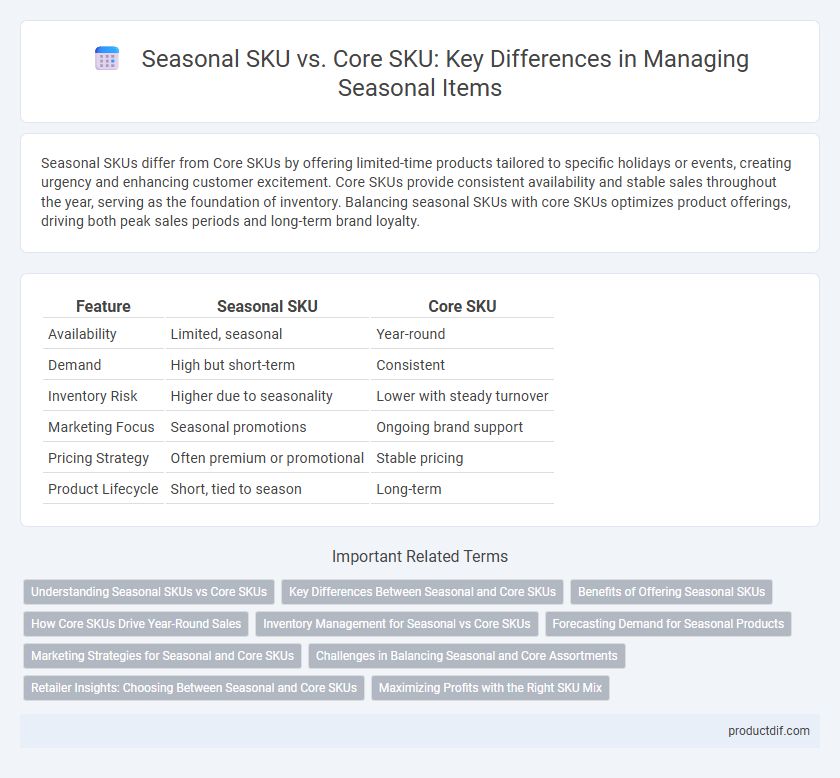Seasonal SKUs differ from Core SKUs by offering limited-time products tailored to specific holidays or events, creating urgency and enhancing customer excitement. Core SKUs provide consistent availability and stable sales throughout the year, serving as the foundation of inventory. Balancing seasonal SKUs with core SKUs optimizes product offerings, driving both peak sales periods and long-term brand loyalty.
Table of Comparison
| Feature | Seasonal SKU | Core SKU |
|---|---|---|
| Availability | Limited, seasonal | Year-round |
| Demand | High but short-term | Consistent |
| Inventory Risk | Higher due to seasonality | Lower with steady turnover |
| Marketing Focus | Seasonal promotions | Ongoing brand support |
| Pricing Strategy | Often premium or promotional | Stable pricing |
| Product Lifecycle | Short, tied to season | Long-term |
Understanding Seasonal SKUs vs Core SKUs
Seasonal SKUs are inventory items tailored for specific periods or holidays, capturing short-term demand spikes, whereas Core SKUs represent staple products with consistent, year-round sales. Unlike Core SKUs, Seasonal SKUs require precise forecasting to optimize stock levels and minimize excess inventory. Efficient management of Seasonal SKUs drives targeted marketing efforts and maximizes revenue during peak seasons.
Key Differences Between Seasonal and Core SKUs
Seasonal SKUs are products available only during specific times of the year to meet fluctuating demand, while Core SKUs are consistently stocked throughout the year due to steady, ongoing customer needs. Seasonal SKUs often have limited production runs and require precise inventory forecasting to avoid overstock or stockouts, unlike Core SKUs that benefit from predictable sales patterns. Marketing strategies for Seasonal SKUs focus on urgency and exclusivity, whereas Core SKUs emphasize reliability and brand loyalty.
Benefits of Offering Seasonal SKUs
Seasonal SKUs provide retailers with opportunities to boost sales during peak periods by aligning inventory with specific holiday or weather-driven demands. These items enhance customer engagement through timely and relevant product offerings, increasing overall brand appeal and market responsiveness. Incorporating seasonal SKUs allows businesses to optimize inventory turnover and reduce the risk of overstock associated with core SKUs.
How Core SKUs Drive Year-Round Sales
Core SKUs maintain consistent demand throughout the year by offering essential products that fulfill customers' ongoing needs, unlike Seasonal SKUs which experience fluctuating sales linked to specific times or events. These core products ensure steady revenue streams, support inventory stability, and enhance supply chain efficiency by reducing dependency on unpredictable seasonal trends. Retailers leverage Core SKUs to build brand loyalty and optimize sales performance across all quarters.
Inventory Management for Seasonal vs Core SKUs
Seasonal SKUs require dynamic inventory management strategies due to fluctuating demand patterns tied to specific times of the year, necessitating accurate forecasting and timely replenishment to avoid stockouts or overstock. In contrast, Core SKUs benefit from steady, predictable demand, allowing for more consistent inventory levels and streamlined supply chain operations. Effective inventory management for seasonal SKUs hinges on rapid responsiveness and flexibility, while core SKU management prioritizes stability and long-term optimization.
Forecasting Demand for Seasonal Products
Seasonal SKU demand forecasting relies heavily on historical sales data, market trends, and external factors such as weather patterns and holidays, distinguishing it from Core SKU forecasting which benefits from consistent, year-round sales. Advanced predictive analytics models incorporate variables like seasonality indices and promotional events to enhance accuracy for seasonal items. Accurate forecasting of Seasonal SKUs prevents stockouts during peak demand and minimizes excess inventory during off-peak periods, optimizing supply chain efficiency.
Marketing Strategies for Seasonal and Core SKUs
Marketing strategies for Seasonal SKUs emphasize time-sensitive promotions and limited-time offers to create urgency and drive quick sales, leveraging trends and holidays to maximize relevance. Core SKUs benefit from consistent branding and long-term loyalty programs that focus on sustained demand and customer retention through regular engagement. Tailoring messaging and advertising channels according to SKU type ensures optimal inventory turnover and revenue growth across seasonal fluctuations.
Challenges in Balancing Seasonal and Core Assortments
Managing Seasonal SKUs alongside Core SKUs presents challenges in inventory forecasting due to fluctuating consumer demand and limited sales history for seasonal items. Retailers face complexity in allocating shelf space efficiently, as seasonal products require timely replenishment while core items ensure consistent turnover. Balancing these assortments demands dynamic demand planning to optimize stock levels and minimize markdowns.
Retailer Insights: Choosing Between Seasonal and Core SKUs
Retailers analyzing sales data reveal that Seasonal SKUs drive short-term spikes in customer engagement by aligning with holidays and trends, while Core SKUs ensure consistent revenue through steady demand year-round. Inventory turnover rates for Seasonal SKUs are higher during peak seasons, demanding precise forecasting to avoid stockouts or overstock. Optimizing product mix based on region-specific consumer behavior enhances profitability by balancing the promotional appeal of Seasonal SKUs with the reliability of Core SKU sales.
Maximizing Profits with the Right SKU Mix
Maximizing profits requires balancing Seasonal SKUs, which capitalize on short-term demand spikes with limited availability, against Core SKUs that provide steady, year-round sales and predictable revenue streams. An optimal SKU mix leverages data-driven demand forecasting and inventory management to avoid overstock and stockouts, minimizing carrying costs while capturing peak market opportunities. Prioritizing high-margin Seasonal SKUs during relevant periods while maintaining robust Core SKU assortments ensures sustained profitability and operational efficiency.
Seasonal SKU vs Core SKU Infographic

 productdif.com
productdif.com